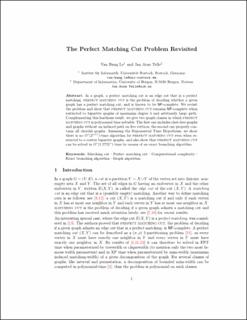| dc.contributor.author | Telle, Jan Arne | |
| dc.contributor.author | Le, Van Bang | |
| dc.date.accessioned | 2022-03-22T11:59:44Z | |
| dc.date.available | 2022-03-22T11:59:44Z | |
| dc.date.created | 2022-01-26T14:46:34Z | |
| dc.date.issued | 2021 | |
| dc.identifier.issn | 0302-9743 | |
| dc.identifier.uri | https://hdl.handle.net/11250/2986792 | |
| dc.description.abstract | In a graph, a perfect matching cut is an edge cut that is a perfect matching. perfect matching cut (pmc) is the problem of deciding whether a given graph has a perfect matching cut, and is known to be NP -complete. We revisit the problem and show that pmc remains NP -complete when restricted to bipartite graphs of maximum degree 3 and arbitrarily large girth. Complementing this hardness result, we give two graph classes in which pmc is polynomial time solvable. The first one includes claw-free graphs and graphs without an induced path on five vertices, the second one properly contains all chordal graphs. Assuming the Exponential Time Hypothesis, we show there is no O∗(2o(n)) -time algorithm for pmc even when restricted to n-vertex bipartite graphs, and also show that pmc can be solved in O∗(1.2721n) time by means of an exact branching algorithm. | en_US |
| dc.language.iso | eng | en_US |
| dc.publisher | Springer | en_US |
| dc.title | The Perfect Matching Cut Problem Revisited | en_US |
| dc.type | Journal article | en_US |
| dc.type | Peer reviewed | en_US |
| dc.description.version | acceptedVersion | en_US |
| dc.rights.holder | Copyright 2021 Springer Nature Switzerland AG | en_US |
| cristin.ispublished | true | |
| cristin.fulltext | postprint | |
| cristin.qualitycode | 1 | |
| dc.identifier.doi | https://doi.org/10.1007/978-3-030-86838-3_14 | |
| dc.identifier.cristin | 1990574 | |
| dc.source.journal | Lecture Notes in Computer Science (LNCS) | en_US |
| dc.source.pagenumber | 182-194 | en_US |
| dc.identifier.citation | Lecture Notes in Computer Science (LNCS). 2021, 12911, 182-194 | en_US |
| dc.source.volume | 12911 | en_US |
